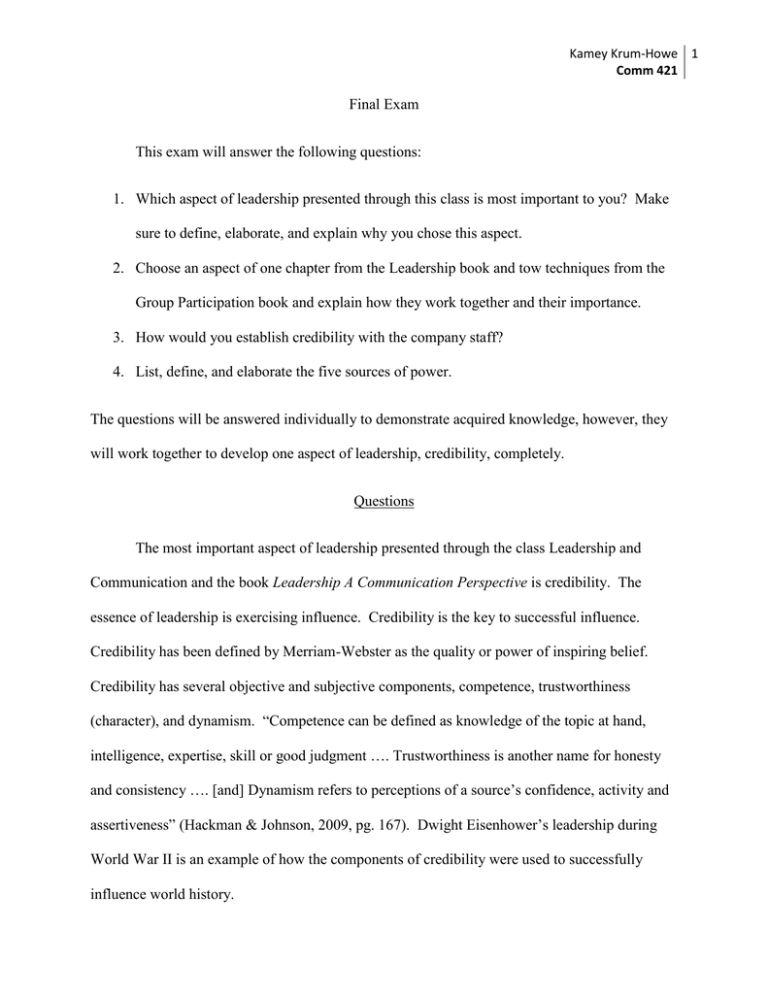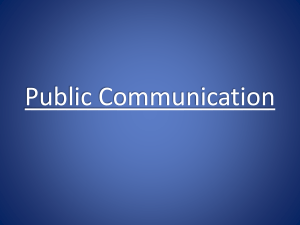Leadership and Credibility
advertisement

Kamey Krum-Howe 1 Comm 421 Final Exam This exam will answer the following questions: 1. Which aspect of leadership presented through this class is most important to you? Make sure to define, elaborate, and explain why you chose this aspect. 2. Choose an aspect of one chapter from the Leadership book and tow techniques from the Group Participation book and explain how they work together and their importance. 3. How would you establish credibility with the company staff? 4. List, define, and elaborate the five sources of power. The questions will be answered individually to demonstrate acquired knowledge, however, they will work together to develop one aspect of leadership, credibility, completely. Questions The most important aspect of leadership presented through the class Leadership and Communication and the book Leadership A Communication Perspective is credibility. The essence of leadership is exercising influence. Credibility is the key to successful influence. Credibility has been defined by Merriam-Webster as the quality or power of inspiring belief. Credibility has several objective and subjective components, competence, trustworthiness (character), and dynamism. “Competence can be defined as knowledge of the topic at hand, intelligence, expertise, skill or good judgment …. Trustworthiness is another name for honesty and consistency …. [and] Dynamism refers to perceptions of a source’s confidence, activity and assertiveness” (Hackman & Johnson, 2009, pg. 167). Dwight Eisenhower’s leadership during World War II is an example of how the components of credibility were used to successfully influence world history. Kamey Krum-Howe 2 Comm 421 “Power is defined as the ability to influence others” (Hackman & Johnson, 2009. pg. 159). Since the essence of leadership is exercising influence, and power is the ability to influence others, and the key to successful influence is credibility, leadership would be impossible without power working to enhance credibility. There are five sources of power: coercive, reward, legitimate, expert and referent. The ability to administer punishment or to give negative reinforcement is the bases of coercive power. For coercion to be most effective the subject must be aware of expectations and know in advance the penalties for failure to comply. An example of a leader using coercive power to build credibility would be, holding a group member accountable to the established contract by not including them on an assignment after having missed two meetings. The base of reward power is the ability to provide something of value to others. The reward can be intangible (e.g. verbal praise) or tangible (e.g. monetary raise), however, the reward must be perceived as desirable to be a motivator. “Legitimate power resides in the position rather than in the person …. The amount of legitimate power someone has depends on the importance of the position she or he occupies and the willingness to grant authority to the person in that position” (Hackman & Johnson, 2009, pg. 141). A student will comply when an instructor (the leader in the classroom) assigns a paper for credit because that is a legitimate request, however, might not be willing to wash the instructors laundry for credit. As a result of this request, the instructor could lose credibility as this could be seen as evidence of the instructor’s poor character. Expert power, the contrast to legitimate power, is based on the person not the position. Experts are highly influential in US culture because they supply needed skills and information. Leaders can use expert power to build credibility such as Steve Jobs did at Apple Computers. Referent power is based on respect, esteem and feelings of affection for someone that is admired and takes a long time to develop. Referent power can be used by Kamey Krum-Howe 3 Comm 421 leaders through their dynamism to inspire others to work harder and to make greater sacrifices. Mike Krzyzeski, head men’s basketball coach for Duke University, is an example of a leader who has established referent power which has enhanced his dynamism that has positively increased his credibility. Two techniques from Harvey Bertcher’s book Group Participation Techniques for Leaders and Members that build and enhance credibility are, attending and information management (seeking and giving information). “Attending is letting a group member know that you are paying close attention to what he or she is saying or doing so that he or she will be encouraged to continue” (Bertcher, 1994, pg. 19). The use of attending contributes to building rapport with followers which builds credibility. Attending is done through several verbal and nonverbal activities. Turn toward the member with a relaxed posture, lean slightly forward, smile, look at them, and then listen. To make sure the follower realizes that you are listening ask questions when you are not sure you understand what has been said. Acknowledge when the member has made an important point by nodding your head and stating “yes” or “right”. Listening cultivates in-depth understanding that communicates to members that they are appreciated, this in-turn builds trust thereby increasing credibility. Information management is used by leaders to, solve problems, build relationships, achieve clarity of communication, and to give and receive feedback. Information management involves both seeking, attempting to add new facts or knowledge to what is already known, and giving, giving facts or knowledge regarding a topic that was unknown to the follower or group. A leader uses information management to build credibility through simple familiar language. By using common, clear, and understandable terminology a leader avoids the impression of distance between them and Kamey Krum-Howe 4 Comm 421 followers. Inviting feedback signals trust and respect for followers. Information management enhances credibility by promoting an atmosphere of information sharing. As a newly hired leader I would establish credibility by employing the process of impression management using the following set of behaviors: self-presentation, fostering perceptions of trustworthiness, discovering myself, increasing skills and confidence, affirming shared values, serving a purpose, developing capacity, and sustaining hope. Before ever being hired a leader must identify their values, this will lay the foundation for consistent behavior. By creating a leadership philosophy that identifies my values, I will be able to communicate with employees using statements that reveal I am human with similar experiences, limitations, and emotions thereby reducing distance. I would also incorporate the use of expert and legitimate power by introducing my qualifications such as, job title, experience and education. Having developed a leadership philosophy and communicated that to employees, will provide opportunities to demonstrate behavioral integrity by matching what I say my philosophy is with my actions; such as being committed to quality leadership and establishing 360 performance reviews. I would reflect concern for employees by asking them to participate in decision making which enables them “to protect their interests, reduces the likelihood that I will take advantage of the situation, and signals trust and respect for their worth and standing in the organization” (Hackman & Johnson, 2009, pg. 170). Bill Hybels has been quoted as saying “Everyone wins when a leader gets better”. A leadership philosophy is nothing without the skills, competency, and confidence to put beliefs into action. Leaders must continue to improve by reading, going to seminars, and seeking out successful mentors. Employees, like leaders, must also continue to develop skills, competency and confidence. As the new leader, I would give employees the authority and latitude to make significant decisions, and provide them with educational Kamey Krum-Howe 5 Comm 421 opportunities. This commitment to developing skills, competency, and confidence at all levels provides “a common language with which we can collaborate” thus affirming shared values. As the leader I would create a sense of direction for employees and communicate this direction by: going first, such as volunteering to open another lane to wait on clients, staying in touch, making meaning on a daily basis by sending consistent message about my philosophy by how I respond to stressful events, establishing systems that create a sense of organizational purpose, and handling failure and the loss of credibility by: accepting responsibility, admitting mistakes, apologizing, taking immediate remedial actions, pay close attention to employee reactions, and making amends or reparations. In this time of volatile business climate due to rapid technological development and uncertain economic and social climate leaders must sustain hope by demonstrating supportiveness, inspiration, and optimism. This exam has developed the aspect of credibility by incorporating terms, concepts and acquired knowledge. Credibility was defined and elaborated through examples. The five sources of power were listed, defined and elaborated through connections to the aspect of credibility. The two techniques, attending and information management, from the Group Participation book were explored and their use in building and enhancing credibility was explained. Knowledge power, credibility and the attending and information management techniques were applied to the real life scenario of establishing credibility as a newly hired leader. Kamey Krum-Howe 6 Comm 421 References Bertcher, H. J. (1994). Group participation: Techniques for leaders and members. (2nd ed., pp. 19-36). Thousand Oaks, CA: Sage Publications, Inc. Hackman, M. Z., & Johnson, C. E. (2009). Leadership a communication perspective. (5th ed., pp. 137-172). Long Grove, IL: Waveland Press, Inc. (n.d.). Retrieved from http://www.merriam-webster.com/dictionary/credibility





